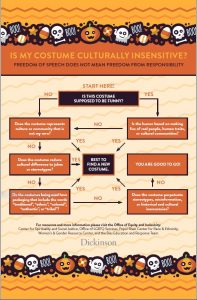It’s that special time of year again: Halloween! While there are many fun, festive traditions of this spooky season, there are some components that are just a little too scary. I’m talking about culturally and socially insensitive costumes that mock people’s lived experiences. All too often we see people dressing up in costumes that stigmatize socially marginalized groups of people, whether it be racial and ethnic groups or the LGBTQ community. But, because there are many popular figures in our culture that are of a specific race or ethnicity, whose persona we might want to adopt, how can we know where to draw the line when picking a costume? Here are a few questions you can ask yourself when deciding:
- Is it based on a community or culture you don’t belong to?
- Would it require you to wear makeup or wigs that resemble a racial or ethnic identity you don’t identify with?
- Do you understand the cultural and historical significance behind the costume?
 If you answered ‘yes’ to the first two questions and ‘no’ to the third one, then that costume is definitely a form of cultural appropriation. Cultural appropriation is defined as “the adoption or co-opting, usually without acknowledgment, of cultural identity markers associated with or originating in minority communities by people or communities with a relatively privileged status.” The cultures that these costumes attempt to portray aren’t a joke for the communities that they come from; they oftentimes hold serious cultural importance that relates directly back to the struggles community members experience daily. For example, wearing an afro wig may seem harmless. But when looking into the history of natural, black hairstyles, it becomes clear that black women’s natural hair was made to seem inferior to straight, Eurocentric hairstyles, thus leading to the idea that black hair, and general blackness, was ugly and undesirable. This is just one instance where the history and deeper cultural significance of a costume is deeply personal for the population that it comes from. That is why it is important to really think about your choice of Halloween costume and its broader implications.
If you answered ‘yes’ to the first two questions and ‘no’ to the third one, then that costume is definitely a form of cultural appropriation. Cultural appropriation is defined as “the adoption or co-opting, usually without acknowledgment, of cultural identity markers associated with or originating in minority communities by people or communities with a relatively privileged status.” The cultures that these costumes attempt to portray aren’t a joke for the communities that they come from; they oftentimes hold serious cultural importance that relates directly back to the struggles community members experience daily. For example, wearing an afro wig may seem harmless. But when looking into the history of natural, black hairstyles, it becomes clear that black women’s natural hair was made to seem inferior to straight, Eurocentric hairstyles, thus leading to the idea that black hair, and general blackness, was ugly and undesirable. This is just one instance where the history and deeper cultural significance of a costume is deeply personal for the population that it comes from. That is why it is important to really think about your choice of Halloween costume and its broader implications.
Some people may still be wondering how a simple Halloween costume can really harm an entire community of people. The answer is simple: by reducing historically oppressed people’s identities to one, stereotypical costume, you are validating the idea that their existence isn’t as important as the dominant, power-holding factions of society. That may all sound very theoretical and abstract, but the reality is still the same. With every disrespectful Halloween costume comes a deeply rooted connection to harmful institutions of power. If you are able to wear a Halloween costume that imitates a certain culture, and then take that costume off at the end of the night without having to think about its cultural significance, then you are actively participating in cultural and racial privilege. And there is no way we can interrupt the power of dominating systems of oppression without looking at the way privilege functions in our own lives.
I know, this all sounds very daunting and terrifying, but in reality, there are ways to challenge these systems in our everyday lives. Choosing an appropriate, respectful Halloween costume is a great way to actively refuse harmful stereotypes about marginalized groups of people, while also taking your own privileges into consideration. I realize that all of this may make the idea of dressing up seem like not as much fun for some people, but don’t let it discourage or damper your Halloween festivities. Instead, think of it as a way in which you are keeping Halloween fun and inclusive for everyone! So this spooky season, have fun and make sure that your costumes are scary for the right reasons.
Written by Maddy Smith ’21, WGRC student worker